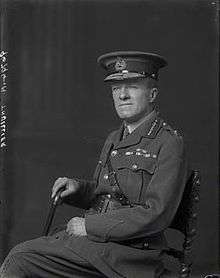Henry Fleetwood Thuillier
Major-General Sir Henry Fleetwood Thuillier KCB CMG, (30 March 1868 – 11 June 1953) was a British Army officer who played a significant part in the development of gas warfare.
Sir Henry Fleetwood Thuillier | |
|---|---|
 Henry Fleetwood Thuillier by Walter Stoneman, 1919. | |
| Born | 30 March 1868 Meerut, Uttar Pradesh |
| Died | 11 June 1953 |
| Allegiance | United Kingdom |
| Service/ | British Indian Army |
| Years of service | 1887–1920 |
| Rank | Major-General |
| Commands held | 2nd Infantry Brigade 15th Division 23rd Division School of Military Engineering 52nd (Lowland) Infantry Division |
| Battles/wars | First World War |
| Awards | Knight Commander of the Order of the Bath Companion of the Order of St Michael and St George |
Early life
Thuillier was born at Meerut, Uttar Pradesh, India, on 30 March 1868, the son of Colonel Sir Henry Ravenshaw Thuillier, KCIE.[1]
Military career
Thuillier was commissioned into the Royal Engineers on 23 July 1890.[2] His early career was spent in India.[1] He became commander of 2nd Infantry Brigade in October 1915, General Officer Commanding 15th Division in June 2017 and General Officer Commanding 23rd Division in Italy in 1918 during the First World War.[3]
After the war he became Commandant of the School of Military Engineering in November 1919, Director of Fortifications and Works at the War Office in 1924[4] and General Officer Commanding 52nd (Lowland) Infantry Division in June 1927 before retiring in March 1930.[5] He died on 11 June 1953.[1]
Selected publications
- The Principles of Land Defence and Their Application to the Conditions of To-Day. 1902.
- Gas in the next war. Geoffrey Bles, London, 1939. (German translation published in Zürich by Scientia, 1939, as Das gas im nächsten krieg. Introduction and notes by V. Tempelhoff).
Family
His son was Lt. Col. Henry Shakespear Thuillier (1895-1982).[6]
See also
References
- "Maj.-Gen. Sir Henry Thuillier", The Times, 13 June 1953, p. 8.
- "No. 26073". The London Gazette. 25 July 1890. p. 4102.
- Hill, Robert (2011). The Marcus Garvey and Universal Negro Improvement Association Papers. 11. Duke University Press. p. 135. ISBN 978-0822346906.
- "No. 32926". The London Gazette. 11 April 1924. p. 3009.
- "Army Commands" (PDF). Retrieved 22 June 2020.
- Bosher, J. F. (2010). Imperial Vancouver Island: Who Was Who, 1850-1950. Xlibris Corporation. p. 727. ISBN 978-1-4500-5962-6.
External links
| Military offices | ||
|---|---|---|
| Preceded by Hamilton Reed |
GOC 52nd (Lowland) Infantry Division 1927–1930 |
Succeeded by Sir Walter Constable-Maxwell-Scott |